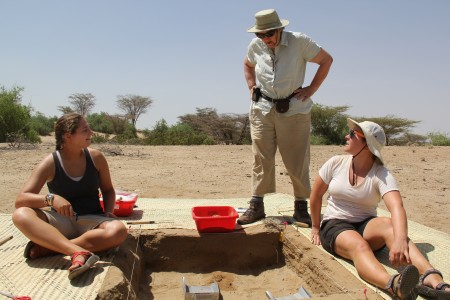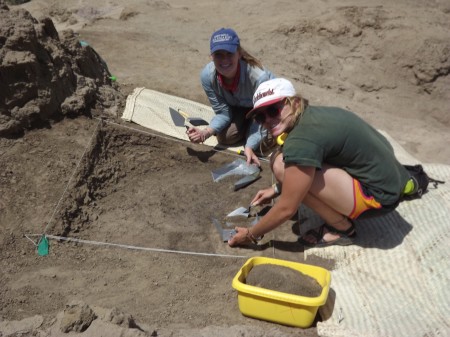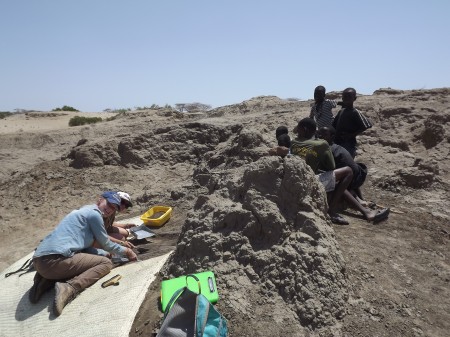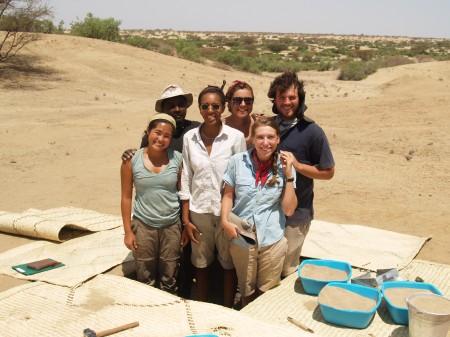The stereotypical image of the exploratory archaeologist doesn’t include a bundle of flags and a GPS. At least not for me. Maybe it includes a whip and a few Nazi’s to fight, but a less fanciful image includes a trowel, a sieve and an exotic backdrop.
Now that we had made some pretty significant discoveries at Kangatotha, including several fragments of very old human skulls, a few pieces of identifiable animal bone, and a complex artifact assemblage, we could move from the roving survey phase of the excavation into our holes to search for undisturbed artifacts.
Every artifact has a lifecyle. It begins its life in the human imagination. A person must imagine how an inanimate object – or group of objects – such as a chunk of wood, a cobble of stone, a zebra rib, or a piece of animal skin that has nothing to do with spearing fish, cutting up roots, holding water, or opening a seed pod could be reshaped and put to this new purpose.
Once the artifact has moved from the imagination through human hands it can be used for its new purpose skewering fish, skinning a goat, or changing the channel from “Real Housewives of New York” to National Geographic. Eventually the artifact serves its purpose or gets lost and hits the ground. Now it waits. Some material is washed away, some gets trampled, but some lucky garbage is deposited with a layer of sediment along with other material. The sediment piles up. Then a river or the wind changes direction and layers are no longer being deposited and are now being worn away.
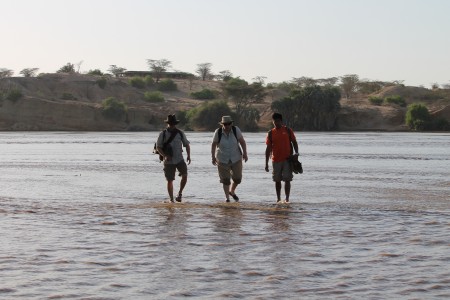
Matt, Dr. Brooks, and Rob crossing the Turkwel River for another day in the field. The Turkwel River perfectly illustrates the preservative and destructive power of water as it lays down new layers of sand and cuts through its own banks the next day.What evidence of TBI has been preserved under our feet? (Photo taken by Cory)
Some of the stuff sitting in the sediment gets worn out of the rock and is hopefully noticed by a curious archeologist. The archaeologist now needs to figure out where the artifact came from so they can get the environmental context of the artifact and figure out what other kinds of artifacts are in the area.
This context is key. An archaeologist can deduce a lot from examining a flake or a point, but there are all kinds of details the artifact was associated with such as pollen grains and animal bones that help reveal the lifestyle of the person who conceived of the object under examination.
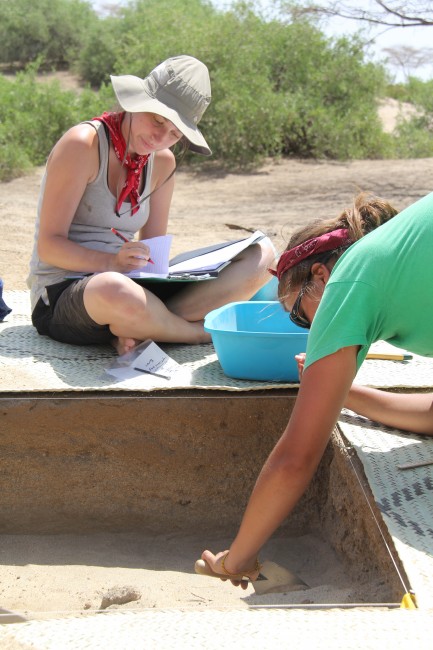
Bailw and Cory carefully record every fragment found on their next layer in order to capture all the details preserved in the ground.
In order to get the broadest sample of the different layers preserved at Kangatotha, the field school established four squares across our sample area in order to capture the changing sediments on the landscape. A square was put above each skull fragment we found, another was put above the harpoon site, and the last was put stratigraphically highest so we could see the full succession of sediments we would be working with.
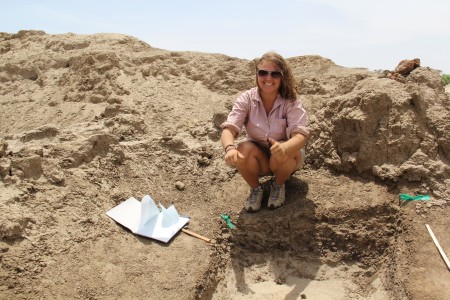
Rosie proudly posing with the exploratory pit she helped excavate in our quest to find the layer that coughed up human remains.
The field school divided into four teams that each took on a square at Kangatotha. Each team was divided into two crews, one actually excavating, the other sieving. The excavators meticulously removed thin layers of sediment, searching for material preserved in situ then collected the material and passed it to the sieving crew. At the sieves – large screens stretched across a frame – any material too small for the excavators to see among the grains of sand were picked out and carefully labeled. The sieving crew was also treated to a thorough dust bath.
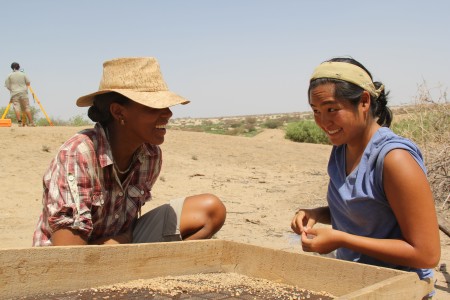
Ana and Holly sort through the sieve. Sometimes there's a little debate about identifications as you paw through the quartz grains...
Some squares yielded artifacts and bone while others became deep, empty pits in the sand, but all excavations were vital for zeroing in on where the material we were finding, especially the human remains, was weathering from.
For three days we returned to Kagatotha to continue the excavation. Each day started with a wade across the fickle Turkwel and a bumpy ride downstream. At the site we divided into square crews and further divided into excavators and sievers. Some students would also help with maintaining the total station record, the laser guided survey that was recording the three-dimensional relationships between everything we found on the surface and everything we found in the excavation squares. This 3D record was especially important because we had set up at two sites and a hot slog through the sand was required to get from one skull site to the other. If we wanted to compare the stratigraphy of one area to the other, we would need a detailed survey record.
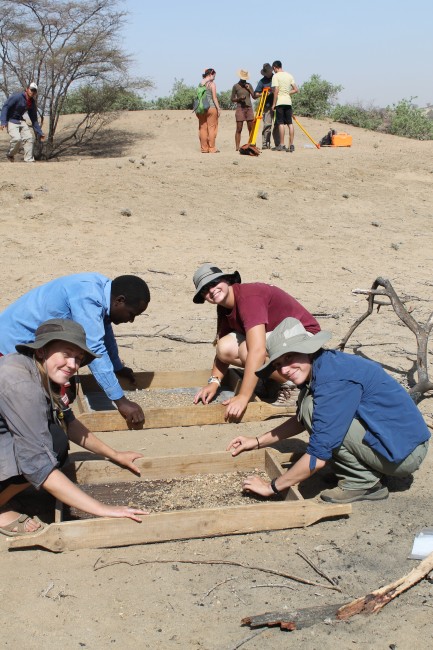
Sieving and surveying at the South Site at Kangatotha. These photos involve a lot of people hunkered down in the dirt. That's what archaeology is all about, right? (Photo taken by Cory)
The final skill the field school students needed to learn was how to meticulously document every find. Archaeology destroys the site with every trowel-ful of sand and we need to keep track of everything removed from the site so future excavators, such as Dr. Lisa Hildebrand of Stony Brook University and future field school students, can pick up where this exploratory crew left off. This means getting out a ruler and a plumb bob and writing the exact depth and position of each little piece. These details can seem a little excessive when you’re sitting in the open desert and it’s over 100 degrees, but they’re sure appreciated once you try to puzzle through what exactly you did out in the field a year or two after the fact.
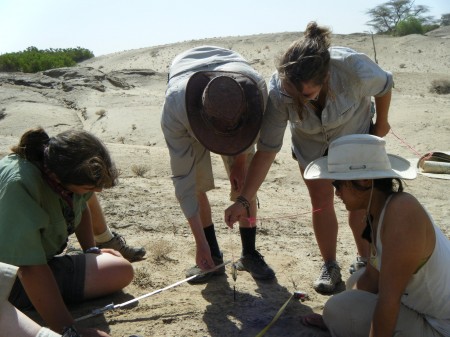
Tim, Marcel, Rosie, and Eve Setting up their grid on their sloping square. It took a lot of meticulous measuring, but they finally got their corners placed and their artifacts out of the ground.
Our highest square was excavated by Sam, Meg, Rachel, Aaron and Leanna. By the luck of the draw they discovered a lot of sand, an ant colony…and not much in the way of artifacts. An important but thankless place to dig as it helped establish the upper horizons of sediment were not producing the human remains and tools and we were dealing with material that was relatively deeply buried.
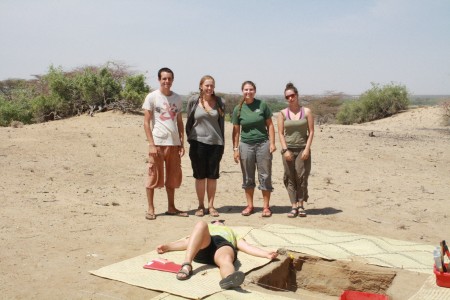
Aaron, Meg, Sam, and Rachel are exhausted after a day of excavation and covering themselves in dust (sieving) but manage to rally the steam to pose proudly. Leanna is also exhausted, but wasn't quite ready to rally.
John, Bailey, Francis, Cory, Ana, and Holly excavated a square just above the spot where Dr. Brooks had found our first mysterious human skull bone. By digging a little above it, they hoped to come down on the layer that produced the cranial fragment. They managed to find several artifacts in their square and helped establish the horizon future excavators should focus on as the full depositional and cultural story of the site is revealed.
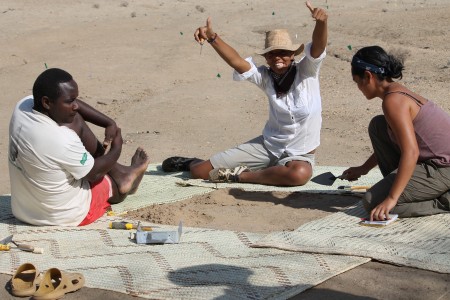
Francis, Ana, and Holly get their corners set and start to move their first layer of sediment. Now to figure out where the artifacts are coming from...(Photo from Cory)
The field crew also learned how to do a detailed survey of the site, better described as a hill crawl to make sure any small fragments of human bone hadn’t been missed. The crawl revealed there was a lot of material at Kangatotha including another fragment of a human skull, a large horse tooth, and large flakes of stone. We really had a good place to dig.
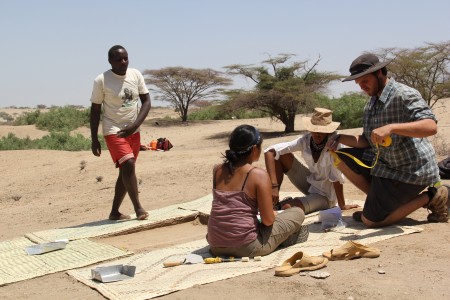
Francis returns from inspecting the survey material as John, Holly, and Ana check the placement of a small stone flake they excavated from their test pit.
Over the sand and along a more hilly outcrop, two more teams created two new holes. Ingrid, Ashley, Rosie, and Natalie were precariously perched over the site where Ingrid and Natalie found the second, larger fragment of human skull. Moving through a fine, silty cap, they finally reached the sandy productive layer just as we were getting ready to pack up. Unfortunately they had to be satisfied with leaving future excavators with an idea of where to dig and what to search for.
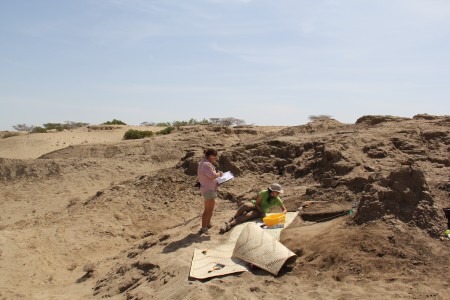
Rosie and Ashley excavating at Kangatotha. So much material to work through and only one small window into the sediment. It's easy to lose perspective and feel a little overwhelmed but at least this one pit is a start. (Photo from Rosie)
Downslope, Eve, Marcel, Maegan, and Tim excavated near the beautiful harpoon Eve had spotted with Rosie on our first survey of the site. As they crawled the area by their future square, they found another harpoon fragment and flakes. An entire tackle box seemed to be eroding from the hill. Unfortunately the excavators discovered what many sandcastle builders before them had learned the hard way: sand doesn’t make a solid wall. After a few days of excavation, the walls came tumbling down.
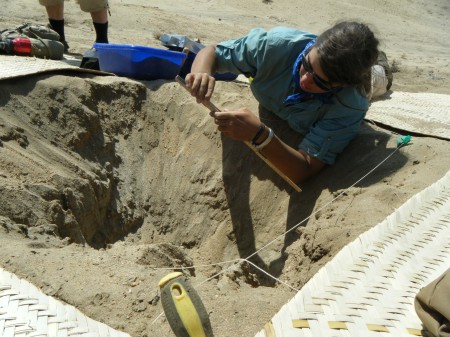
Tim in the pits. The sandy walls didn't support themselves and the intense wind didn't help keep things together. After wrapping up the sediment notes, it was time to focus on more surface surveying...and finding more human remains. (Photo from Maegan)
They sketched the stratigraphy they had seen so far then began a detailed surface survey of the area on the last day. They quickly discovered more human remains along with teeth and jaws from the animals that shared the landscape with the people we were finding. Again, the last day. Again, they would have to be satisfied that future excavators would appreciate the effort.
On Friday, after the sediments were documented and the closing finds were safely cataloged, and just as everyone was getting into the swing of the excavation…we had to pack it up.
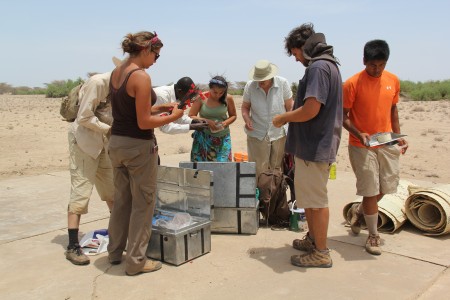
Packing up Kangatotha. This won't be the last time trowels and sieves make an appearance on these platforms.
What had started as an exercise in teaching excavation techniques on a site that really wouldn’t contribute very much to the story of Turkana Basin prehistory had become a site that potentially represents a key early interval in the evolution of modern humans. Until further excavations take place and more squares are dug, it’s difficult to say much more, but Dr. Brooks’s enthusiasm for the material the students were producing was infections. Kangatotha became a place to get into real archaeology.
You dig?

